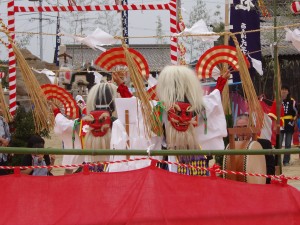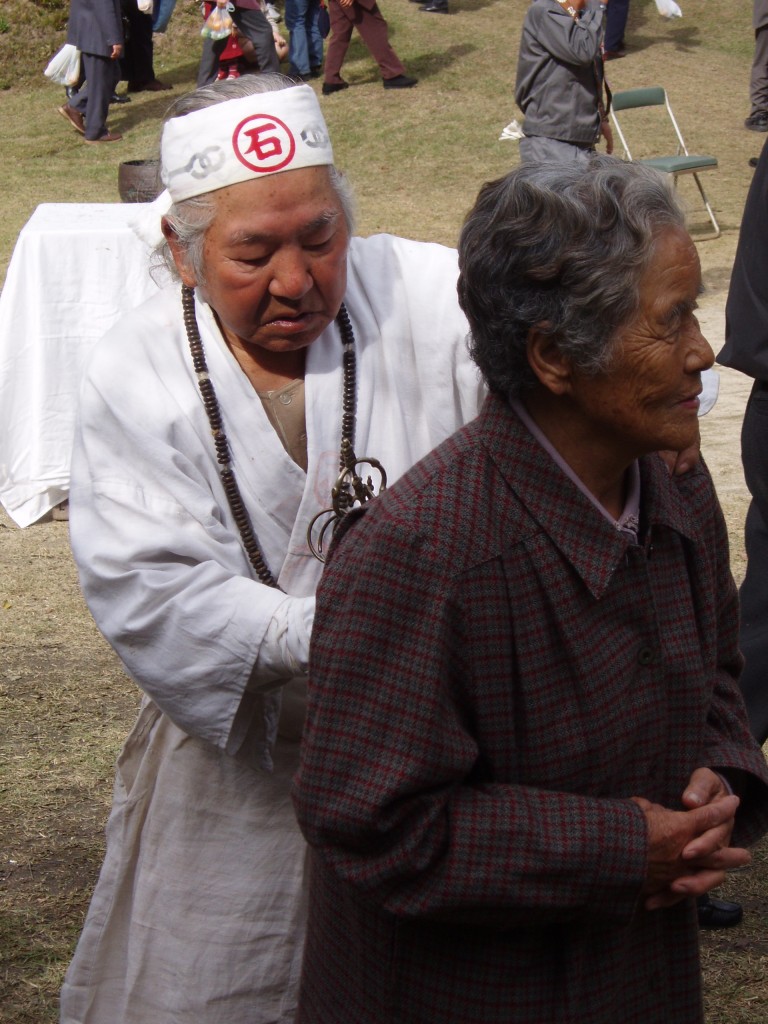
Navaho shaman
In Navaho cosmology all beings have a natural place, and when they are in balance the universe is a place of beauty. However, aspects of the universe have a tendency to fall into disharmony, and ceremonies need to be held to restore the natural balance. Any form of disturbance has to be controlled in this way, particularly those caused by the dead (angry ghosts). Even good people can become vindictive after death and need to be dealt with.
Shinto too has traditionally been much concerned with the pacification of hungry spirits, and the Tenmangu cult is one such famous instance when it was believed that the angry spirit of Sugiwara no Michizane (845-903) needed to be placated by deification and worship. The Japanese preoccupation with spirits is seen above all in Noh and in the annual Obon return of the dead. Indeed, a belief in ancestral spirits may be the most fundamental Japanese mindset. (See here.)
For the Navaho, contact with certain animals is considered a source of impurity and disharmony, and there are many taboos about them. In Shinto it is rather contact with blood and death. In both cases the potential contagion seemed to ancient cultures as threatening to the life force.
As animists, both the Navaho and Shinto imagine the universe to be teeming with spirits. As well as those of natural phenomena, there are the ancestral spirits and cultural gods. For the Navaho the greatest of the latter is the Changing Woman, who has two children by the Sun – Monster Slayer and Born for Water. This is echoed in Shinto mythology by the primacy of the shamaness-weaver Amaterasu and her brother, the monster-slaying Susanoo associated with the sea.

Masked drama, Shinto style
There are other spirits in the Navaho cosmology, known as yei. As with the kami, the yei are not necessarily benevolent to humans and have to be placated in order to maintain harmony. In Navaho ceremonies they are sometimes portrayed by masked dancers, reminiscent of the kagura masked dance-drama of Shinto.
Navaho culture is full of taboos, to do with rules of social contact, sexual activity, treatment of the dead, sacred objects, being untidy or dirty, etc etc. Breaking a taboo is not a sin as such, but a cause of disharmony necessitating a ceremony to restore balance. Correct performance of rituals is absolutely crucial in terms of effectiveness, a trait which characterises Shinto too. Any mistake may cause the spirits to be offended and harmony will not prevail. Perhaps here lies the famed Japanese aversion to making mistakes!
A major component of Navaho ceremony consists of requests for blessing. These ‘blessingways’ are individual rather than communal, and may be to do with childbirth, marriage, a new home, the protection of livestock or a departing soldier, etc. Shinto too offers individual rites of this type. But the spiritual healing ceremonies that are prevalent among the Navaho are absent from modern Shinto, presumably because in the transition from shaman to priest the practice was lost. Something of the old ways remains in Shugendo, however, and practitioners of mountain asceticism still carry out spiritual healing to this day.

Shugendo practitioner applying some spiritual healing
*******************************************************************************************
Information draws on Sacred Hoop Issue 73, article by Nicholas Breeze Wood, as well as Shamanism, An Encyclopedia of World Beliefs, Practices and Culture by Marko Namba Walter et al

I had the great fortune many years ago to talk with a Navajo lady who may have been a priestess herself. She described a ceremony to me, and I was struck with the similarities to Shinto. Just as at Kompira, they had the women sit on the left and the men on the right. They had similar offerings I recall, too, except that in place of rice they used corn pollen.